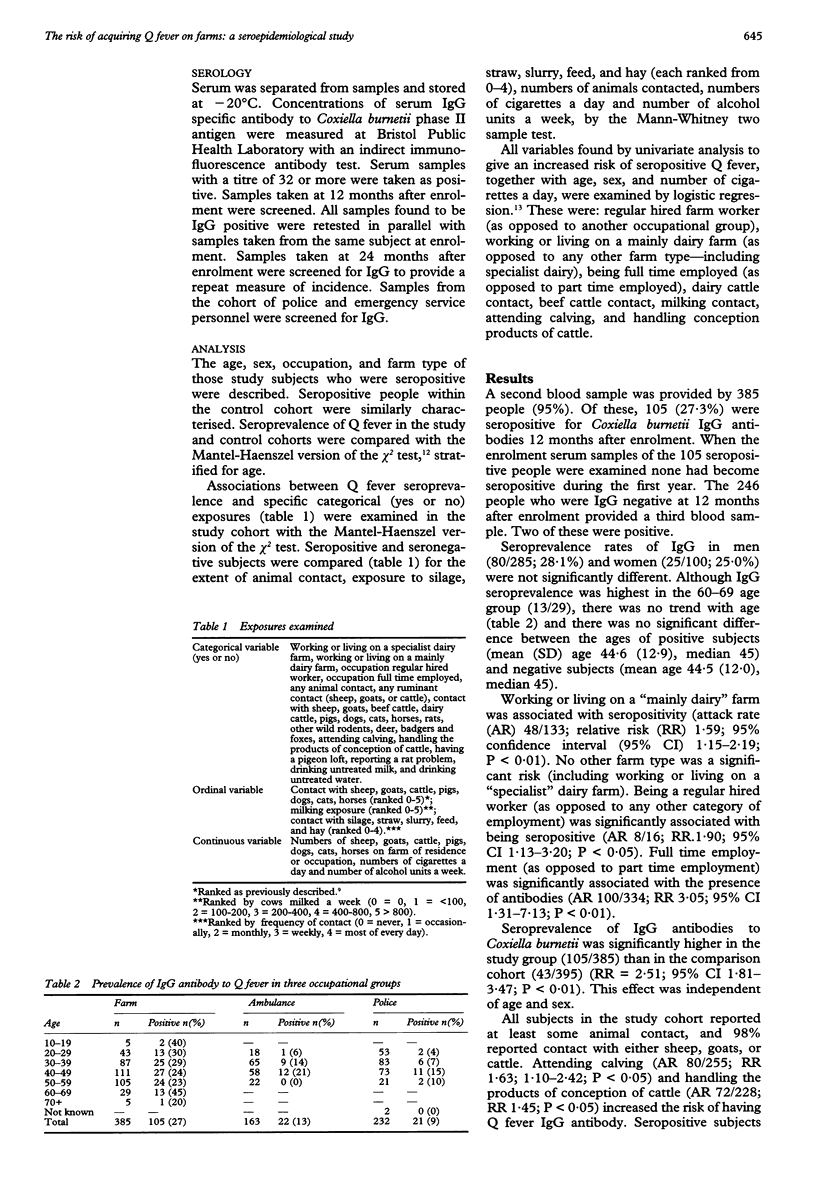Abstract
OBJECTIVES--To determine the occupational risk of Q fever. DESIGN--Cohort study. SETTING--Community: five English local authority districts. SUBJECTS AND METHODS--Prevalence and incidence of immunoglobulin G (IgG) specific antibody to Coxiella burnetii phase II antigen was measured in a representative (study) cohort of farm workers in the United Kingdom, and detailed exposure data were collected. Also seroprevalence of Q fever in a (control) cohort of police and emergency service personnel was measured. RESULTS--Prevalence was significantly (P < 0.01) higher in the study cohort (105/385 v 43/395). During the first 12 month period after enrollment no seroconversions were found (upper 95% confidence limit: 1318/100,000/year). During the second 12 month period after enrollment two seroconversions were found, equalling an incidence of 813/100,000/year (95% confidence interval (95% CI) 98-2937/100,000/year). No association was found between seroprevalence and age. In the study cohort, extent of total contact with farm animals seemed more important than exposure to any specific animal: full time employees were more than four times more likely to be antibody positive than part time employees (P < 0.05). Exposure to cattle, but not sheep, goats, cats, raw milk, and hay (all reported sources of Q fever) was associated with being positive to Coxiella burnetii IgG by univariate analysis but this association was not independent of total farm animal contact. CONCLUSIONS--The risk of Q fever on livestock farms is related to contact with the farm environment rather than any specific animal exposure. The absence of an increasing prevalence with age suggests that exposure may occur as clusters in space and time (outbreaks).
Full text
PDF



Selected References
These references are in PubMed. This may not be the complete list of references from this article.
- Campos-Filho N., Franco E. L. Epidemiologic programs for computers and calculators. A microcomputer program for multiple logistic regression by unconditional and conditional maximum likelihood methods. Am J Epidemiol. 1989 Feb;129(2):439–444. doi: 10.1093/oxfordjournals.aje.a115148. [DOI] [PubMed] [Google Scholar]
- Fishbein D. B., Raoult D. A cluster of Coxiella burnetii infections associated with exposure to vaccinated goats and their unpasteurized dairy products. Am J Trop Med Hyg. 1992 Jul;47(1):35–40. doi: 10.4269/ajtmh.1992.47.35. [DOI] [PubMed] [Google Scholar]
- Jorm L. R., Lightfoot N. F., Morgan K. L. An epidemiological study of an outbreak of Q fever in a secondary school. Epidemiol Infect. 1990 Jun;104(3):467–477. doi: 10.1017/s0950268800047476. [DOI] [PMC free article] [PubMed] [Google Scholar]
- Kosatsky T. Household outbreak of Q-fever pneumonia related to a parturient cat. Lancet. 1984 Dec 22;2(8417-8418):1447–1449. doi: 10.1016/s0140-6736(84)91633-7. [DOI] [PubMed] [Google Scholar]
- Langley J. M., Marrie T. J., Covert A., Waag D. M., Williams J. C. Poker players' pneumonia. An urban outbreak of Q fever following exposure to a parturient cat. N Engl J Med. 1988 Aug 11;319(6):354–356. doi: 10.1056/NEJM198808113190607. [DOI] [PubMed] [Google Scholar]
- Marrie T. J., Durant H., Williams J. C., Mintz E., Waag D. M. Exposure to parturient cats: a risk factor for acquisition of Q fever in Maritime Canada. J Infect Dis. 1988 Jul;158(1):101–108. doi: 10.1093/infdis/158.1.101. [DOI] [PubMed] [Google Scholar]
- Marrie T. J., Schlech W. F., 3rd, Williams J. C., Yates L. Q fever pneumonia associated with exposure to wild rabbits. Lancet. 1986 Feb 22;1(8478):427–429. doi: 10.1016/s0140-6736(86)92380-9. [DOI] [PubMed] [Google Scholar]
- Morgan-Capner P., Hudson P., Armstrong A. Hepatitis B markers in Lancashire police officers. Epidemiol Infect. 1988 Feb;100(1):145–151. doi: 10.1017/s0950268800065638. [DOI] [PMC free article] [PubMed] [Google Scholar]
- Morgan-Capner P., Wallice P. D. Hepatitis B markers in ambulance personnel in Lancashire. J Soc Occup Med. 1990 Spring;40(1):21–22. doi: 10.1093/occmed/40.1.21. [DOI] [PubMed] [Google Scholar]
- Palmer S. R., Young S. E. Q-fever endocarditis in England and Wales, 1975-81. Lancet. 1982 Dec 25;2(8313):1448–1449. doi: 10.1016/s0140-6736(82)91341-1. [DOI] [PubMed] [Google Scholar]
- Pinsky R. L., Fishbein D. B., Greene C. R., Gensheimer K. F. An outbreak of cat-associated Q fever in the United States. J Infect Dis. 1991 Jul;164(1):202–204. doi: 10.1093/infdis/164.1.202. [DOI] [PubMed] [Google Scholar]
- Reilly S., Northwood J. L., Caul E. O. Q fever in Plymouth, 1972-88. A review with particular reference to neurological manifestations. Epidemiol Infect. 1990 Oct;105(2):391–408. doi: 10.1017/s095026880004797x. [DOI] [PMC free article] [PubMed] [Google Scholar]
- Salmon M. M., Howells B., Glencross E. J., Evans A. D., Palmer S. R. Q fever in an urban area. Lancet. 1982 May 1;1(8279):1002–1004. doi: 10.1016/s0140-6736(82)92000-1. [DOI] [PubMed] [Google Scholar]
- Sanzo J. M., Garcia-Calabuig M. A., Audicana A., Dehesa V. Q fever: prevalence of antibodies to Coxiella burnetii in the Basque country. Int J Epidemiol. 1993 Dec;22(6):1183–1188. doi: 10.1093/ije/22.6.1183. [DOI] [PubMed] [Google Scholar]
- Senn S. A note concerning the analysis of an epidemic of Q fever. Int J Epidemiol. 1988 Dec;17(4):891–893. doi: 10.1093/ije/17.4.891. [DOI] [PubMed] [Google Scholar]
- Thomas D. R., Salmon R. L., Kench S. M., Meadows D., Coleman T. J., Morgan-Capner P., Morgan K. L. Zoonotic illness--determining risks and measuring effects: association between current animal exposure and a history of illness in a well characterised rural population in the UK. J Epidemiol Community Health. 1994 Apr;48(2):151–155. doi: 10.1136/jech.48.2.151. [DOI] [PMC free article] [PubMed] [Google Scholar]


